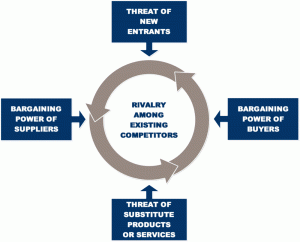Monitor mystery writer Dexter Van Dango gives us a lesson on Harvard Business School professor and author Michael Porter and his Five Forces of Competition, asking, “How do you stack up?”
How does your business stack up against the competition? Are you evolving to stay competitive in the future with your products, services and delivery methods?
A quote from one of the Private Independent leasing company survey participants highlighted in the cover story of the Mar/Apr 2015 edition of the Monitor caught my attention. It accurately and quite succinctly captured the current leasing and finance industry competitive landscape. The quote was as follows, “We saw a more competitive marketplace in our space with new entrants and pricing pressures. Best-in-Class service and online finance offerings continue to be the difference makers in the space.”
Through a simple response to a survey question the participant unknowingly drew from the writings of esteemed Harvard Business School professor and author Michael Porter and his Five Forces of Competition (see graph).

New Entrants
We have seen many new entrants jump into our market recently, including regional banks and foreign investors. Aquiline Capital Partners — a former investor in Tygris Commercial Finance, which was sold to Everbank — recently announced a strategic investment in ENGS Commercial Finance. Century Tokyo Leasing staked a claim in the U.S. and global markets when it purchased approximately 35% of CSI Leasing. Likewise, Stonebriar Commercial Finance commenced operations with backing from Security Benefit Corporation, part of an insurance company conglomerate. And Huntington Bancshares announced a deal to buy Macquarie Equipment Finance. One would think that the barriers to entry to the U.S. leasing and finance market would be quite high, considering the capital requirements and regulatory environment. However, the available financial returns are viewed favorably as the U.S. economy continues to show signs of sustained strength.
Bargaining Power of Suppliers
The survey respondent referenced competitive pricing conditions. In a manufacturing business companies buy raw materials to build products and inventory then sell them for cash. In our industry, cash, or borrowing capacity, is our raw material. If the Federal Reserve is the ultimate supplier of our raw material then we have enjoyed a prolonged period of plentiful supply with very little bargaining power from the supplier. With interest rates continuing at historic lows, this condition cannot last forever. But for some, it is time to make hay while the sun shines. Take advantage of the opportunity before it expires.
Bargaining Power of Customers
At the height of the Great Recession customers had lost any bargaining power they once had. Credit was so tight that only gilded names could pass muster. By 2011 the landscape began to change and by 2012 there was excess capital available in the marketplace and too little demand for it. Competition got fierce and customers regained their bargaining power. Today, the same remains true; however, customers are smarter, more cautious and more diligent in their approach toward CapEx spending.
Threat of Substitute Products or Services
The survey respondent wrote “Best-in-Class service and online finance offerings continue to be the difference makers in the space.” An online finance offering may represent a substitute product from a lessor that has no online presence. A well-crafted online solution can reduce the need for people and the expense that goes with them. To compete in the small ticket market, efficient and easy-to-use online tools are a required ante. Differentiated services can also make a competitor stand out among rivals. In Porter’s writings he stresses that if you are not the low cost producer, you cannot compete on price — you must compete on differentiation or value add. If you are not a depository institution and don’t have the lowest cost of funds, how do you differentiate your products and services to add value?
Rivalry Among Existing Competitors
Our industry can be intensely competitive, but not unlike others, we tend to evolve. Think of the owner of a small independent gas station, the only one serving an entire community. What happens when a national chain affiliate builds across the street from his station? He tries to compete by lowering gas prices a few pennies at a time. But eventually he is driven out of business or changes his business model. Look around your neighborhood and you are likely to find a car repair business that used to be a filling station. You see, the big chains don’t offer services — just competitively priced fuel and not so competitively priced milk, beer and tobacco products. While the big national chain is competing on price, the independent is differentiating through added value services.
One Reply to “Porter’s Five Forces of Competition”
Brilliant piece of work. Are there any positives and negatives of using Porter’s five forces model.